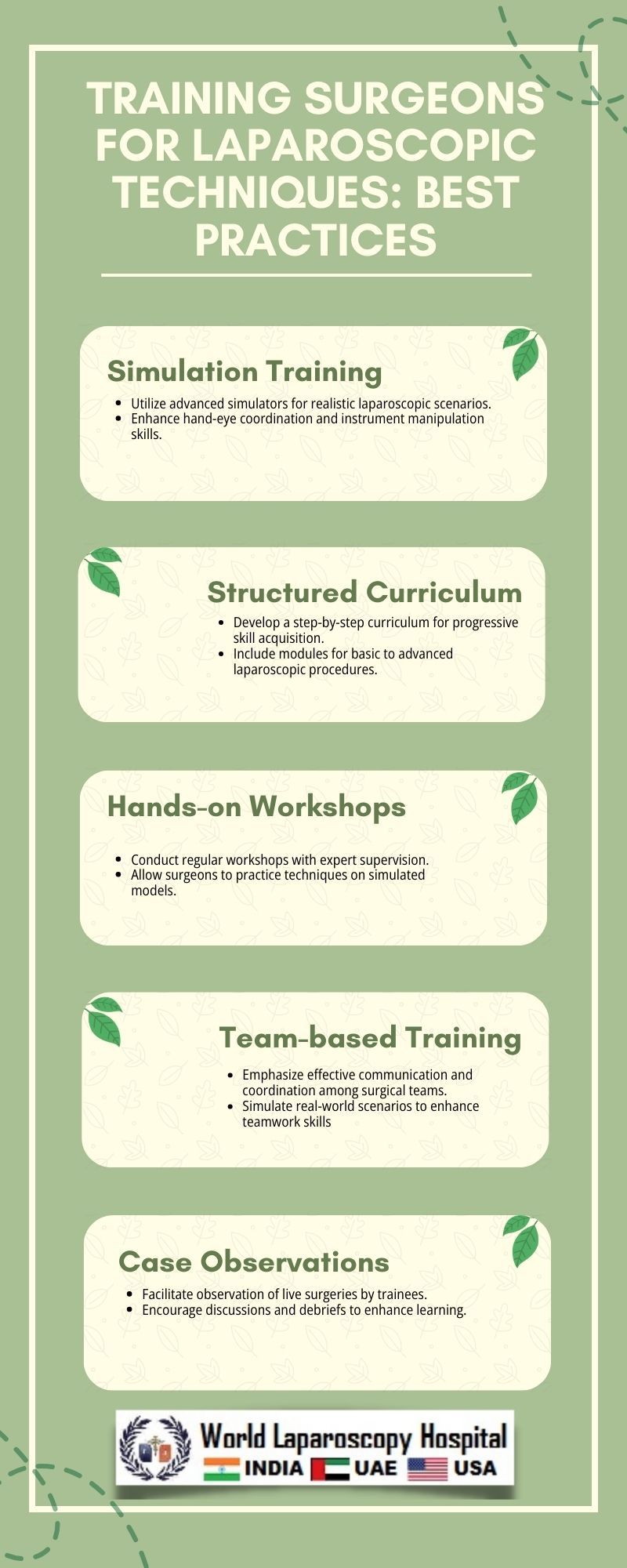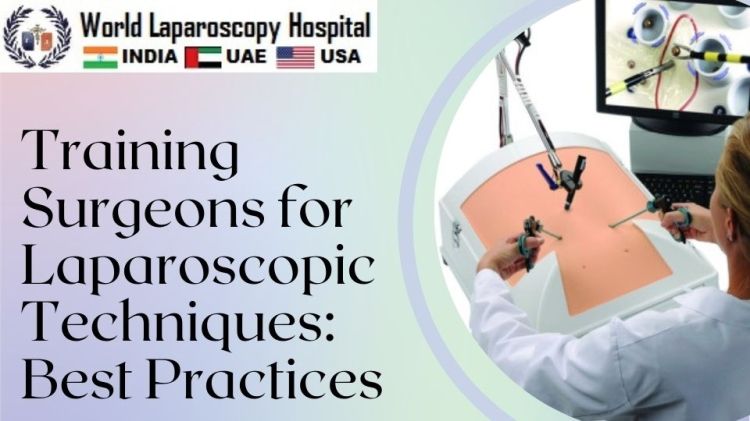Training Surgeons for Laparoscopic Techniques: Best Practices
Introduction:
Laparoscopic surgery has revolutionized the field of surgery, offering patients less invasive procedures and quicker recovery times. However, mastering the delicate and precise techniques required for laparoscopic procedures demands specialized training. This article explores the best practices in training surgeons for laparoscopic techniques, emphasizing the integration of didactic education, simulation-based learning, and supervised clinical experience.

The Importance of Laparoscopic Training:
Laparoscopic surgery, also known as minimally invasive surgery, involves performing procedures through small incisions with the aid of a camera and specialized instruments. While this approach offers numerous benefits, such as reduced pain, shorter hospital stays, and faster recovery, it necessitates unique skills not traditionally acquired during standard surgical training.
Didactic Education:A solid foundation in laparoscopic techniques begins with comprehensive didactic education. Surgeons must understand the principles of laparoscopy, including instrumentation, trocar placement, and three-dimensional spatial awareness. Didactic education is typically delivered through lectures, workshops, and online resources, ensuring surgeons grasp the theoretical aspects before transitioning to hands-on training.
Structured Curricula:
Incorporating structured curricula into surgical training programs is essential. These curricula should cover the fundamentals of laparoscopic surgery, starting with basic skills and progressing to advanced procedures. A stepwise approach allows surgeons to build competence gradually, instilling confidence as they acquire proficiency in each skill set.
Virtual Reality Simulators:
Virtual reality (VR) simulators play a pivotal role in laparoscopic training. These advanced tools replicate realistic surgical scenarios, providing a safe environment for surgeons to practice and refine their skills. VR simulations offer tactile feedback and real-time performance metrics, enabling objective assessment and continuous improvement. Integration of VR into training programs enhances hand-eye coordination, depth perception, and instrument manipulation.
Simulation-Based Learning:Simulation-based learning is a cornerstone of laparoscopic training, allowing surgeons to hone their skills in a risk-free environment before entering the operating room. Simulation offers several advantages:
Skill Repetition:
Repetitive practice is crucial for skill acquisition. Simulators provide surgeons with the opportunity to repeat procedures until they achieve proficiency. This repetition builds muscle memory, enhancing precision and efficiency during actual surgeries.
Procedural Familiarity:
Simulators enable surgeons to become familiar with specific procedures and instruments. This familiarity translates to increased confidence and competence when facing similar scenarios in real-world surgical settings.
Team Training:
Laparoscopic procedures often involve a surgical team. Simulation-based training facilitates team coordination and communication, fostering a collaborative environment. Team members can practice their roles, ensuring seamless workflow and patient safety.
Supervised Clinical Experience:While didactic education and simulation lay the groundwork, supervised clinical experience is irreplaceable in the final stages of laparoscopic training. The transition from simulation to the operating room is critical for integrating learned skills into real-world practice.
Mentorship:
Mentorship is a key component of supervised clinical experience. Novice laparoscopic surgeons benefit from the guidance of experienced mentors who can provide insights, feedback, and troubleshooting assistance. Mentorship fosters a supportive learning environment and accelerates the development of surgical proficiency.
Gradual Progression:
The transition from simulation to actual surgical cases should be gradual. Surgeons should start with simpler laparoscopic procedures under close supervision and progressively advance to more complex surgeries as their skills evolve. This incremental approach minimizes the risk of errors and ensures a smooth integration of laparoscopic techniques into the surgeon's repertoire.
Continued Professional Development:
Laparoscopic training is an ongoing process that extends beyond initial certification. Continuous professional development through workshops, conferences, and case reviews keeps surgeons abreast of evolving techniques, technologies, and best practices. Staying current is essential for providing patients with the most advanced and effective care.
Objective Assessment:
Assessing laparoscopic skills objectively is crucial for identifying areas of improvement and ensuring the highest standard of patient care. Various assessment tools and metrics can be employed to evaluate a surgeon's proficiency in laparoscopic techniques:
Global Rating Scales:
Global rating scales, such as the Objective Structured Assessment of Technical Skills (OSATS), provide a comprehensive evaluation of a surgeon's performance. These scales assess technical skills, instrument handling, and overall competence, offering valuable insights into an individual's proficiency.
Performance Metrics:
Utilizing performance metrics from virtual reality simulators allows for quantifiable assessment. Metrics such as time taken to complete a task, accuracy, and economy of motion provide objective data for evaluating a surgeon's skill level.
Continuous Feedback:
Regular, constructive feedback is essential for continuous improvement. Surgeons should actively seek feedback from mentors, colleagues, and self-assessment to identify areas for growth. Establishing a culture of open communication and continuous learning contributes to the ongoing development of laparoscopic skills.
Conclusion:
Training surgeons for laparoscopic techniques is a dynamic process that combines didactic education, simulation-based learning, and supervised clinical experience. By integrating these best practices, surgical training programs can ensure that aspiring laparoscopic surgeons acquire the necessary skills and confidence to perform minimally invasive procedures successfully. As technology and techniques continue to evolve, the commitment to ongoing education and skill refinement remains paramount in advancing the field of laparoscopic surgery and improving patient outcomes.
